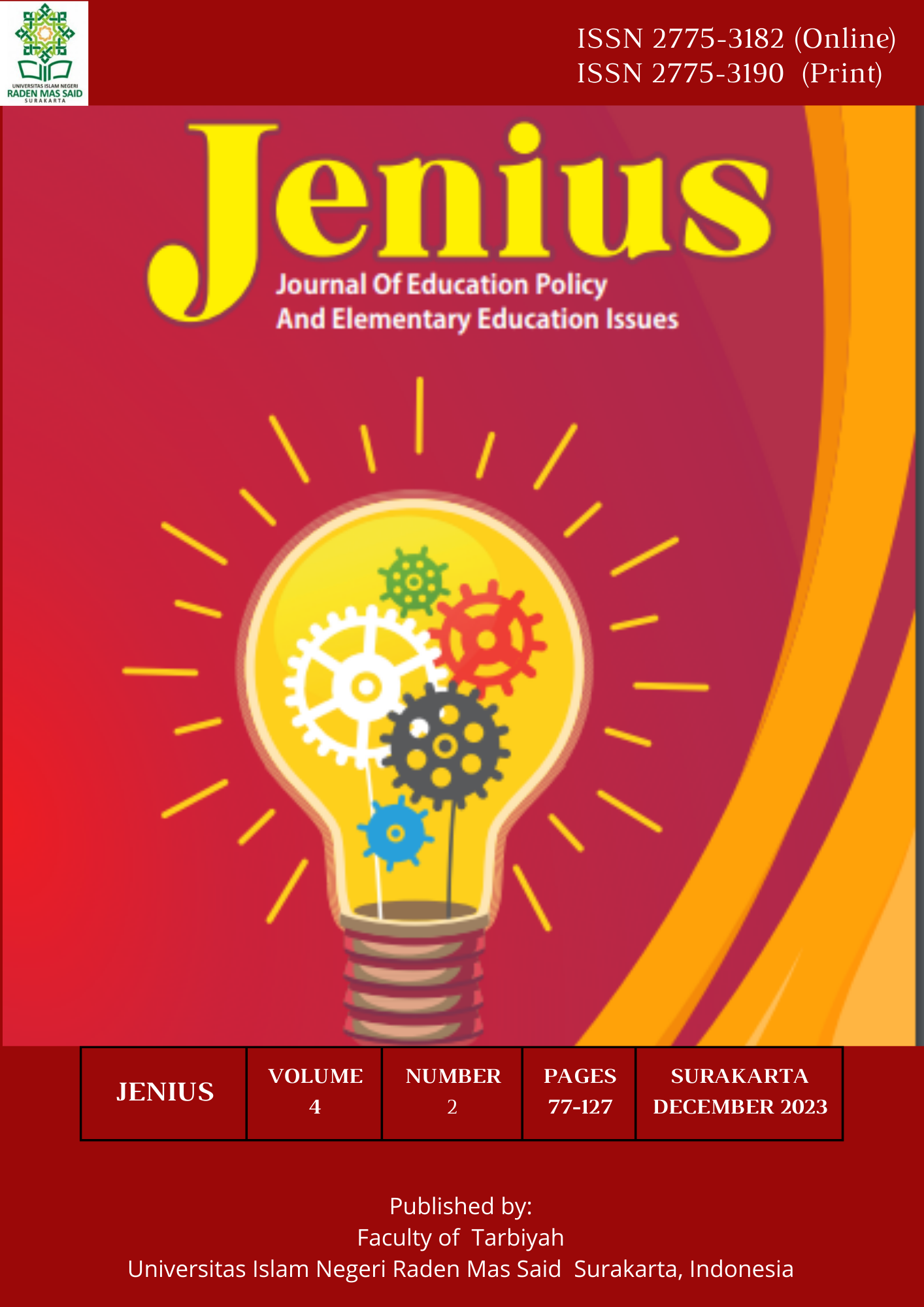The Influence of Lecture and Question and Answer Methods Assisted by Video Learning Media on Primary School Students' Science Critical Thinking Abilities
Main Article Content
Keywords
Critical thinking skills, Lecture method, Question and answer method, Video learning media
Abstract
The ability to think critically is a process of understanding and examining a problem or object by actively considering and evaluating statements and ideas that have meaningful value. This study aims to determine students' critical thinking skills in science subjects after being given treatment by applying lecture and question-and-answer methods with the help of video learning media. This research was conducted at Madrasah Ibtidaiyah Muhammadiyah Klaseman Gatak. The study was conducted in November 2022. The research method used is pre-experimental—data analysis using a paired sample t-test. The instrument used in this study is a critical thinking ability test in the form of a description of 9 questions. Validation in this research instrument is expert validation and empirical validation. Expert validation was given to two expert lecturers, and empirical validation was given to 21 grade IV B MI Muhammadiyah Klaseman students. The study sample was 22 students in class IV A, with a population of 43. The study's results averaged a pretest score of 57.24 while the average posttest score of 63.47 obtained a significant value, 0.069>0.05, so Ho was accepted, and Ha was rejected. It can be concluded that there is no significant influence on the use of lecture and question-and-answer methods with the help of learning media on students' critical thinking skills in grade IV science subjects at Muhammadiyah Islamic Elementary School Klaseman
Downloads
References
Arikunto, S. 2002. Prosedur penelitian suatu pendekatan praktek. Edisi: IV. Jakarta: Rineka Cipta.
Fakhriyah, F. (2014). Penerapan problem based learning dalam upaya mengembangkan kemampuan berpikir kritis mahasiswa. Jurnal Pendidikan IPA Indonesia.3(1). https://doi.org/10.15294/jpii.v3i1.2906
Finken, Ennis. (1993). Illinois critical thingking eassy test. Champaign: Department of Educational Policy Studies.
Fisher, Scriven. (2009). Berpikir kritis: Sebuah pengantar, terj dari critical thinking: An introduction oleh benyamin hadinata. Jakarta: Erlangga.
Gunantara G, Suarjana & Riastini. (2014). Penerapan model pembelajaran problem based learning untuk meningkatkan kemampuan pemecahan masalah matematika siswa kelas v. MIMBAR PGSD Undiksha,2.(1). https://doi.org/10.23887/jjpgsd.v2i1.2058
Hadi, S & Novaliyosi. (2019). TIMSS indonesia (trends in international mathematics and science study). Jurnal Prosiding Seminar nasional & Call For Papers. https://jurnal.unsil.ac.id/index.php/sncp/article/view/1096
Hendryadi. (2017). Validitas isi: Tahap awal pengembangan kuesioner. Jurnal Riset Manajemen dan Bisnis Fakultas Ekonomi UNIAT, 2.(2). https://dx.doi.org/10.36226/jrmb.v2i2.47
Khulalil, A & Tyasmiami. (2021). Pengaruh metode ceramah terhadap hasil belajar dalam pelajaran matematika kelas I SDN telang 1. Prosiding Nasional Pendidikan:LPPM IKIP PGRI Bojonegoro.https://prosiding.ikippgribojonegoro.ac.id/index.php/Prosiding/article/view/1110
Kuswana, Wowo Sunaryo. (2011). Taksonomi berpikir. Bandung : Penerbit Remaja Rosdakarya.
Lumatenggo, U, (2011). Teknologi komunikasi dan informasi pembelajaran. Jakarta: Penerbit PT Bumi Aksara.
Mulyadi, D. U.,S. Wahyuni, & R. D. Handayani. (2016). Pengembangan media flash flipbook untuk meningkatkan keterampilan berfikir kritis siswa dalam pembelajaran IPA di SMP. Jurnal Pembelajaran Fisika, 4(4). https://jurnal.unej.ac.id/index.php/JPF/article/view/2728
Pabesak, Risma Rombe, & Santoso, Magdalena Pranata. (2023). Penerapan metode ceramah dan tanya jawab dalam proses pembelajaran daring di SD kristen di medan. Jurnal Aletheia, 4(1). https://doi.org/10.9744/aletheia.4.1.1-8
Prasetyo, AD. (2021). Peningkatan hasil belajar konsep dasar IPA melalui model pembelajaran jigsaw. Jurnal Jenius: Journal of Education Policy and Elementary Education Issues, 2(1). https://doi.org/10.22515/jenius.v2i1.3622
Purbarani, DA, Nyoman D, dan Putu B. (2018). Pengaruh problem based learning berbantuan media audio visual terhadap kemampuan berpikir kritis dan hasil belajar IPA di sekolah dasar. PENDASI: Jurnal Pendidikan Dasar Indonesia, 2(1). https://doi.org/10.23887/jpdi.v2i1.2689
Sanjaya, W. (2010). Strategi pembelajaran berorientasi standar proses pendidikan. Jakarta: Penerbit Media Group.
Septikasari, R. (2018). Keterampilan 4C abad 21 dalam pembelajaran pendidikan dasar. Jurnal Tarbiyah Al-Awlad,8(02). https://doi.org/10.15548/alawlad.v8i2.1597
Setyowati, R & Suprapti. (2022). Frist grade elementary school students' reflective thingking skills in thematic learning. Jurnal Jenius: Journal og Education Policy and Elementary Education Issues, 3(1). https://doi.org/10.22515/jenius.v3i1.4957
Sudjana, N. (2010). Dasar-dasar proses belajar mengajar. Bandung: Penerbit Sinar Baru Algensindo.
Trimahesi, I, dan Agustina. (2019). Peningkatan kemampuan berpikir kritis dan hasil belajar pada mata pelajaran matematika menggunakan model realistic mathematics. Thinking Skills and Creativity Journal, 2(2). https://doi.org/10.23887/tscj.v2i2.22272


